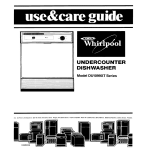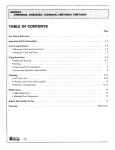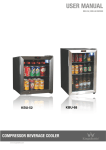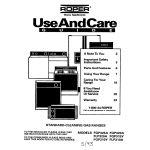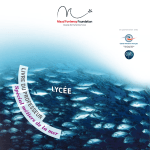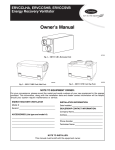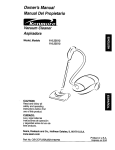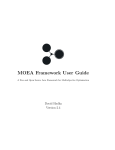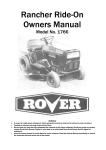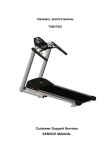Download Carrier HRVCCLHA Unit installation
Transcript
to the Expertg_
rn
Installation
TABLE
Instructions
OF CONTENTS
PAGE
SAFETY
CONSIDERATIONS
INTRODUCTION
UNIT
INSTALLATION
WALL CONTROL
CONTROL
CARE
2
...............................
2
3
........................
.....................................
ERV
..................................
EVALUATION
BOARD
OPERATION
TROUBLESHOOTING
DIAGRAM
9
................................
the
unit
and
other
safety
Follow all safety codes. Installation
must be in compliance
with
local and national building
codes. Wear safety glasses, protective
clothing, and work gloves. Have fire extinguisher
available. Read
these instructions
thoroughly
and follow all warnings
included in literature and attached to the unit.
Recognize
safety
information.
This is the safety-alert
or cautions
symbol
z_.
manuals, be alert to the potential for personal injury. Understand
these signal words; DANGER.
WARNING,
and CAUTION.
These
words are used with the safety-alert
symbol. DANGER
identifies
7
...............................
with
5
6
.........................
labels attached
to or shipped
precautions
that may apply.
When
6
......................
by trained service personnel.
When working
on this
observe precautions
in the literature, on tags, and on
5
5
........................
AND MAINTENANCE
WIRING
1
...................................
ACCESSORIES
VENTILATION
...................
.......................
CONNECTIONS
BALANCING
1
CONSIDERATIONS
DESCRIPTIONS
ELECTRICAL
1
...................................
INSTALLATION
COMPONENT
.........................
performed
equipment,
10
you
see
this
symbol
on
the
unit
and in instructions
or
the most serious hazards which will result in severe personal injury
or death. WARNING
signifies hazards
which could result in
personal
practices
property
injury or death. CAUTION
is used to identify unsafe
which may result in minor personal injury or product and
damage. NOTE is used to highlight
suggestions
which
will result
in enhanced
installation,
reliability,
or operation.
INTRODUCTION
The ERVCCLHA
Energy
Recovery
Ventilator
is used to exchange
indoor stale air with outside fresh air. The unit is equipped with a
special energy recovery
core which transfers
both sensible and
latent heat between the fresh incoming
air. The cross-flow
design
core allows entering and leaving air streams to transfer heat energy
without
The
mixing.
ERVCCLHA
(See Fig. 2.)
is available
in 2 sizes with
60-148 CFM (28 - 71 L/s), and 60-183
design of this unit is horizontal.
Special
2
airflow
to duct application,
balancing
the ERV. and locating
access and routine maintenance.
INSTALLATION
ranges
of
CFM (28 - 89 L/s). The
attention should be given
unit for easy
CONSIDERATIONS
Inspect Equipment
Move
carton to final
installation
location.
Remove
ERVCCLHA
unit. Remove
all packaging
A07619
Fig. 1 - ERVCCLHA
Energy
Recovery
from carton taking care not to damage
Ventilator
and inspect unit for damage. Remove parts bag from inside unit.
File claim with shipping
company
if shipment
is damaged
or
incomplete. Check to make sure ERV unit matches Fig.1.
NOTE:
Read
installation.
the entire
SAFETY
instruction
manual
Untrained
as cleaning
personnel
personnel
should
install,
can perform
and replacing
starting
the
can be hazardous
Only
trained
repair, or service
basic maintenance
Select
Location
The ERV should
CONSIDERATIONS
Installation
and servicing of this equipment
to mechanical
and electrical
components.
qualified
before
due
and
this equipment.
functions
air filters. All other operations
such
must
be
be located
proximity
to a fused power
for routine maintenance.
in a conditioned
source.
It should
space and in close
be easily
accessible
If ERV is installed independent of a forced-air
system, unit should
be located near the center of the air distribution
system. If ERV is
installed in conjunction
with a forced-air system, unit should be
located next to (or close to) the indoor equipment.
Independent
STALE A_R
TO OUTSIDE
System
Application
In tire absence of a forced-air
system and a typical duct system
layout, the ERV can be applied as an independent
or stand alone
unit. To ensure comfort, this type of application
involves running
both fresh-air
throughout
and return-air
registers
(or stale-air
pickup
registers)
the home.
Fresh-air
registers
are normally
located
in bedrooms,
dining
rooms,
living rooms,
and basements.
It is recommended
that
STALE AiR
FROM BU/_tNG
FRESH AIR
F_OM OUTSIDE
registers be placed 6 to 12" (152 to 305 mm) from the ceiling on an
interior wall and airflow directed toward the ceiling. If registers are
floor installed, airflow should be directed toward the wall.
A07572
Fig. 2 - ERV Airflow
During
Air Exchange
n
A07613
Fig. 3 - ERVCCLHA
Component
Components
Description
Tire following
listed
items
are components
of ERVCCLHA
(see
Fig. 3).
1. Stale
air return
system.
2. Fresh-air
from building
connected
to return-air
Fig. 4 - Chain
intake connected
to outdoor
3. Exhaust-air
connected
4. Mechanical
filters trap dust contained
to outdoor
hood.
6. Blowers bring
air to outside.
stale-
7. Electronic
forced
control
supply
from
circuit
from
ensures
outside
and exhaust
proper unit operation.
ERV connected
to return-air
duct of
CARBON
MONOXIDE
Failure to follow
or death.
10. Electrical
connector
block
cord connects
UNIT
Do
DAMAGE
for wiring
to standard
wall and timer
115v outlet.
The ERV
result
in personal
injury
pickup registers)
Return-air
(or stale-air
pickup
draw from kitchens, bathrooms,
stale-air can exist.
registers) are normally
located to
basements,
or other rooms where
Proper
must be used to minimize
size and type of registers
Maximum
according
HAZARD
install
ERV
in
a
may
result
or
existing
forced-air
supply and stale-air
from
floor joists
using
chains
and 4
springs. Attach metal hanging bracket to all 4 sides of cabinet (see
Fig. 4). The unit may be installed on a shelf if an isolation pad is
provided to dampen vibration.
Unit should always be installed as
level as possible.
should
pressure
not be above
Data Digest for ventilation
capacities.
will be installed
in conjunction
with new or
systems.
To operate properly,
the fresh-air
return from ERV connect directly to return-air
duct system. This is how the ERV distributes fresh air and removes
stale air from inside of building (see Fig. 5). For these installations,
Unit
can be suspended
register
Application
Most ERV applications
contaminated
through
length of duct for the system should be designed
to the highest speed of the unit. Refer to specifications
Forced-Air
corrosive
of airflow
listed in unit Product
in equipment
atmosphere.
Mount
could
con-
INSTALLATION
to follow
this caution
or improper operation.
not
this warning
HAZARD
Do not install return-air
registers (or stale-air
in same room as gas furnace or water heater.
drop. The velocity
400 ft per minute.
Failure
damage
POISONING
air system.
9. Terminal
trols.
UNIT
Installation
in the air.
sensi-
in fresh-air
Spring
air inlet hood.
air exhaust
5. Energy recovery core is a cross-flow
type. It transfers
ble and latent energy between the 2 air streams.
8. Fresh-air
A9226g
duct
furnace
or
continuously
NOTE:
fan coil blower
must be interlocked
whenever ERV is energized.
The fresh
air from ERV is introduced
at a point no less than 6 ft (1.8 m) upstream
and
operate
into return-air
of furnace
duct
or fan coil.
This connection
should be direct (see Fig. 5). This is to allow
incoming fresh-air to mix before entering indoor equipment.
eliminate
transmission
of noise or vibration
from unit to main duct
system. In addition, there are four 30" (762 mm) duct ties provided
to help fasten flexible duct to port on ERV.
Locate
and
IMPORTANT:
flexible
outlet
Install
Exterior
To
prevent
ducts are required
ducts connecting
Fresh-air
Hoods
condensation
problems,
on both fresh-air
between
intake and stale-air
ERV and exterior
exhaust
insulated
inlet and exhaust-air
wall.
must be separated
by at least
6 ft (1.8 m). Fresh-air
intake must be positioned
at least 10 ft (3 m)
from nearest dryer vent. furnace exhaust, driveway, gas meter, or
oil fill pipe. Fresh-air
intake must be positioned
as far as possible
from garbage
containers
and potential
chemical
fumes. When
possible, it is advised to locate the intake and exhaust hoods on
santo side of house or building.
The intake and exhaust
hoods
should never be located on interior corners or in dead air pockets
(see Fig. 5). Both intake and exhaust hoods must be 18" (457 mm)
from ground and at least 12" (305 mm) above anticipated
snow
level.
/4_7 ram)
After selecting proper hood locations, make appropriate
size hole
through exterior wall, pass flexible duct through hole and insert
A07617
Fig.5 -
Exhaust
Ventilation
hood tube into duct. Tape duct vapor barrier tightly around
tube and insert assembly back into wall and fasten securely.
WALL
hood
CONTROL
Location
The ERV wall control is unique to this unit.
operate without it. This control senses humklity
The ERV will not
not temperature.
It
nmst be located in an area where it will continually
monitor fresh
air circulating within the home. Install ERV wall control as close as
possible to main system thermostat and follow same guklelines
as
installing a thermostat
(locate approximately
5 ft (1.5 m) above
DUCTS
RETURN
floor, mount
CONNECTING
TO
AiR DUCT SYSTEM
A07610
Remove
Fig. 6 - Flexible Duct Fit-Up
Ducts to ERV
Connect
on an inside partitioning
wall, etc.).
Wiring
top cover assembly
wire through
hole located
from wall control
on back of control
and pass thermostat
before
attaching
to
wall. Connect
Y. R. G, and B (yellow. red, green, and black)
between wall control and ERV connector following color code (see
Fig. 7 and 8). Replace top cover assembly.
NOTE:
PROPERTY
DAMAGE
ERV wall control
and circuit
board
operate
on 12 VDC.
HAZARD
Failure to follow this caution may result in minor property
damage from sweating
duct or loss of unit efficiency
and
capacity.
ERV should be installed in a conditioned
space with insulated
flex duct for supply and exhaust air to the outdoor ambient.
Insulated
exhaust-air
flexible duct is required
on both flesh-air
inlet and
outlet
ducts connecting
to exterior
wall. When
RED
using insulated flexible duct, the vapor barrier of the flexible ducts
must be taped very tightly to prevent condensation
problems.
To
reduce pressure drop, stretch the flex duct and support it in a proper
manner to avoid reduced airflow.
When
flexible
connecting
the ERV to a return-air
duct can be used.
When
using
duct system,
metal
duct from
connecting
ducts
to return-air
duct
system.
This
BLACK
insulated
fresh-air
supply to system duct work. the metal duct should be insulated (see
Fig. 6). However,
when metal or rigid ducts are applied use
approximately
18" (457 mm) of flexible duct at ERV ports for
fresh-air
supply and stale-air
return.
This can act as a silencer
when
YELLOW
should
GREEN
A00112
Fig. 7 - Typical
Wall
Control
n
NOTE:
AI_ _XCHmG_
0N
The
ERV
control.
The
ERV
4-Zone
Damper
may be controlled
using
the Infinity
may be
using
either
Module.
the NIM of a 4-Zone
O
o
o
OneTouch
SS%_
See the appropriate
Damper
Module
system
a NIM
instructions
fer connection
or a
if using
instructions.
Control
The OneTouch control may be used as the primary wall control for
the ERV. This control will step through the modes of operation
with consecutive
presses of the button. The LED indicates which
Im_ER_mW_m
_
%R_LAYW_HU_
connected
_XT _E_m
_ m'C;S0 F
mode is currently selected: Off, Intermittent,
Low, or High. There
is no humidity
sensor on the OneTouch.
and it will not provide
direct humidity
Latent
control.
Control
NOTE:
To ensure highest
season, the INTERMITTENT
Blower
A07611
Fig. 8 - Control
Connector
has 4 basic modes
interlock
relay
is not
needed
for use with
control. The Infinity system control
the ERV and the indoor blower.
will
in cooling
the Infinity
simultaneously
Push Button Timers may be used and are connected to the ERV as
shown in Figure 9. However,
the Infinity system should be set to
continuous
fan to ensure that the fresh air is circulated in the home.
Operation
The ERV wall control
system
control
degree of humidity
control
mode should be used.
of operation,
OFF, LOW,
HIGH. and INTERMITTENT.
Be sure that all modes of operation
are fully functional.
See Table 1 indicating
standard
control
In a Zoned
fan.
System,
at least one zone should
be set to continuous
operation.
1. With switch OFF, ERV is inoperative
2. With switch
with outside.
and the LED is out.
on LOW. ERV continuously
If control is satisfied, blower
speed, otherwise, blower will run on HIGH
is illuminated
all the time.
3. INTERMITTENT-If
building is higher
speed.
highest degree of humidity control
mittent mode should be used.
in cooling
season,
inter-
.......
[
F
i
i
The humidity
selector is a built-in
control designed
control the level of humidity
in the house during
months.
This acts like a limit switch. See Table
becomes
_-
-5
®@@
@®@
,, -,,
,
,
• __ _, I °J
turn
DAMPER
FAN
SPEED
Off
Ctosed to outside
Off
Low
Air exchange with
outside
Open to outside
Low
Intermittent
Air exchange with
outside
Open to outside
Low
High
Air exchange with
outside
Open to outside
High
Off
i
--
_
OmrONAL)
pus_ Buvlo_ SWH CriES
5 SW_lC_ 8 MAXIMUM)
o
(oc)
co_o_
BLACK 0 ,_S4)
_RM_N&L
_m_P
POSITION
OPERATION
RED
--BLACK
-- YELLOW
too dry in winter
1 - Basic Control
MODE
-1-
--
,,,, I o I
to properly
the summer
2 to select
months,
put wall control in INTERMITTENT
mode and
down humidity selector to provide ventilation less frequently.
Table
{J3 -3)
ooI2F
e®e
J1
o0 Mf_U_E IfMER
level. If the house
OR
OL
Selection
humidity
B [NDICAI
BLACK 0 COMMON {Ja 4)
RE# o £W[lCH (Ja 5)
relative
humidity
level inside
of
than setpoint, then no air exchange will
reaches setpoint. This mode is ideal for maintaining
proper
humidity
level when continuous
mode cannot. To ensure
maximum
YELLOW
The LED
occur and ERV shuts off. If relative humidity
level inside
building is lower than setpoint, then air exchange
occurs at
high speed, and shuts down ERV when humidity
level
Humidity
J3
exchanges
air
will run in low
_DCA OR
_EHM_L
S_mlp
o
BACK OF PUSN BU_TON SW_TCN
A98386
Fig. 9 - Push Button
OPERATING
THE
INFINITY
Table
OUTSIDE
TEMPERATURE
50°F / 10°C
32 o F, / 0 o (
14°F/ 10%
4°F/ 20°C
22°F/ 30°C
2 - Recommended
Humidity
DOUBLE-PANE
WINDOWS
55%
45%
35%
30%
25%
Levels
TRIPLE-PANE
WINDOWS
65%
55%
45%
45%
35%
Timer
W'iring
ERV
Layout
WITH
THE
CONTROL
The ventilator has four settings
in cooling mode.
in heating
mode
and three settings
Heating:
AUTO
- the ventilator
selects the speed based on indoor
humidity
and outdoor temperature.
It may cycle on/off every
30 minutes
depending
on humidity
LOW
- low speed
all of the time.
HIGH
- high speed all of the time.
and outside
temperature.
DEHUM
- willonlyturnonif humidity
is3%oversetpoint.
Thespeed
is determined
by indoorhumidity
andoutdoor
temperature.
Cooling:
AUTO- theventilator
selects
thespeed
based
onindoor
humidity
andoutdoor
temperature.
It maycycle
on/offevery
30minutes
depending
onhumidity
andoutside
temperature.
LOW- lowspeed
allofthetime.
HIGH- highspeed
allofthetime.
If thefanspeed
issettoAutoandtheventilator
wants
torun,the
fanspeed
will runatHighcontinuous
speed.
Otherwise,
thefan
willstay
atthechosen
continuous
fanspeed.
ELECTRICAL
within
the home.
dampers
Balancing
the ERV
is done by using balancing
in the fresh air intake and stale air exhaust
ducts.
Airflow
is determined
by temporarily
connecting
a magnehelic
gauge to the pressure taps on ERV. (See Fig. 10.) Balancing
chart is
located on unit door.
CONNECTIONS
A98400
Fig. 10 - Magnehelic
ELECTRICAL
SHOCK
Failure to follow
or death.
this warning
If supply-air
from outside is greater than exhaust-air
from the
house, an imbalance
can result over pressurizing
the home. If
exhaust-air
is greater than supply-air,
combustion
appliances may
HAZARD
could result
in personal
injury
Before installing
or servicing
system, always turn off main
power to system.
There may be more than 1 disconnect
switch.
backdraft,
condition
customers,
Wiring
The
operates
ERV
on
115
VAC.
It comes
with
a power
attached to unit and ready to plug into a fused outlet.
grounded for proper operation.
and Local
The ERV circuit board, wall control, and accessories operate on 12
VDC. See Wall Control section, item Wiring and Fig. 7 and 8 fnr
more information.
wired
when
with an integrated
interlock.
The interlock
can be
to the system blower to ensure that the blower is running
there is a call for ventilation.
See the wiring diagram for
proper wiring
of the interlock
circuit.
ACCESSORIES
20 Minute
Timer
A push button timer can be used to override
put the ERV into high speed for 20 minutes.
parallel and connect
Fig. 9). Push button
such as bathrooms
operation
is needed
NOTE:
The
ERV
wall
function
20 minute
control
is
is internal
momentary
illuminate
timer
between
the push button.
and
function
working
circuit
board,
OC and OL. The
The maximum
timers that can be applied
is 5.
60 Minute
Timer
Adjustable
of time.
will not
applied
to electronic
contact
the wall control and
Connect switches in
leads to ERV terminals
L OC, and OL (see
locations
are ideal in special activity areas,
or kitchens,
where
high-speed
exhaust
for a short period
properly
unless
correctly.
Timing
ERV terminals
timer
in parallel
or to
ERV
Balancing
intake and exhaust airflow is very important
for proper
system operation
and optimum
performance
when applying
an
ERV. Unit balancing
prevents
a positive
and/or
negative
pressure
that
2 --
unit
the
to high
hoods,
bath or roof fans
speed.
furnace/air
handler
blower
is ON
if the
(0"C), make sure the unit is not running
(By waiting 10 minutes after plugging
that the unit is not in a defrost
Magnehelic
Step
3 --
flow
pressure
gauge
gauge
Connect
on a level surface
tubing
cycle.)
placement.
from
gauge
and adjust
it to zero.
to EXHAUST
air
taps.
Be sure to connect the tubes to their appropriate highdow fittings.
(See Fig. 11.) If the gauge drops below zero, reverse the tubing
connections.
NOTE:
because
It is suggested to start with the exhaust air flow reading
the exhaust has typically more restriction than the fresh air.
especially
ventilation.
in cases of fully ducted installations
Place the magnehelic
gauge upright
equivalent
chart.
AIR FLOW
Move
taps.
timers,
sure
Set the
Place the magnehelic
Step
OC and OL (see Fig. 9).
BALANCING
Step
is to
with push button
fume
Procedure
1 --
the unit in. you are assured
by a
of push button
exhaust,
temperature
is below 32°F
in defrost while balancing.
I connection
number
dryer
installation is in any way connected to the ductwork of the cold air
return. If not, leave furnace/air
handler blower OFF. If the outside
it is activated
A 60 minute adjustable
timer can also be used to override wall
control and put ERV into high-speed
operation for a select amount
of time. Connect
Step
Make
Wiring
The ERV comes
top exhausts,
all windows,
doors,
and
No exhaust systems such as
should be in operation.
The forced-air
furnace
(if used for
circulation)
should be operating in continuous fan mode for normal
operating speed.
Balancing
All electrical connections
nmst comply with National
Electrical Codes, or other ordinances
that might apply.
12 VDC
cord
Unit must be
bringing
exhaust
fumes into the house. A balanced
will ensure
optimum
performance,
provide
satisfied
and avoid expensive callbacks.
Before
proceeding
with balancing,
fireplace flues should be tightly closed.
range
115 VAC
Gauge
4 --
tubing
of the reading
to FRESH
or source point
and level. Record
according
air flow
to the balancing
pressure
Adjust the fresh air balancing
damper until the fresh air flow is
approximately
the same as the EXHAUST
air flow. If fresh air
flow is less than exhaust
air flow, then go back and adjust the
exhaust
balancing
Step
5 --
Secure
with
tape.
Step
6 --
Write
the required
Record
damper
both
air
to equal the fresh air flow. (See Fig. 11.)
dampers
flow
thumb
screw
in place
information.
air flow information
on a label
the unit for future reference (date, maximum
name, phone number and business address).
speed
and stick it near
air flows,
your
n
NOTE:
The
difference
flows.
of -+10 CFM
unit
is considered
balanced
even
if there
(or -+5 1/s or 17 m3/h) between
is a
the two air
Freshair flow
Balancing Dampers
Balancing
dampers
(sometimes
called butterfly
dampers)
are
located in fresh-air
intake and stale-air exhaust of the ERV. (See
Fig. 11.) Some field modification
may be required to ensure proper
adjustment
of balancing
dampers while located in flexible duct.
Insulating
balancing
over these dampers
is complete to prevent
is strongly
condensation
recomnmnded
problems.
after
NOTE:
Temporary
flow collars are not needed with the new
ERVCCLHA
models
since
the air flow
pressure
taps
are
incorporated
in the access door. (See Fig. 11.)
VENTILATION
EVALUATION
ExhaustAirFI0w
A05264
Fig. 11 - Balancing ERVCCLHA
CONTROL
Failure
to follow
efficiency, capacity
this caution
or unit life.
may
result
in
reduced
To ensure proper operation
located on electronic control
Sizing
3 - Ventilation
FLOOR
AREA(if2)
0-1
2-3
<1500
30
45
Air Requirements,
60
75
encountered,
NOTE:
check jumpers
Power
CPU when changing
for 30 seconds
exchange
The ERV measure the incoming air temperature and will cycle unit
in and out of defrost, depending
on outdoor ambient. The intake
60
75
90
105
75
90
105
120
4501-6000
75
90
105
120
135
6001-7500
90
105
120
135
150
>7500
105
120
135
150
165
damper
and defrost.
will close and circulate
10 minutes. This time depends
for defrost cycle.
Table
0-1
2-3
14
21
139.1-279
21
279.1-416
28
416.1-557
557.1-697
<139
>697
BEDROOMS
4-5
to reset the
90
60
Air Requirements,
is required
jumpers.
>7
45
4 - Ventilation
to make sure they are located properly.
disconnect
The ERV continually
monitors outside air temperature. If outside
air is at or below 23 ° F (-5 ° C), ERV will cycle between
air
3001-4500
FLOOR
AREA (m2)
jumpers
are
configuration
Outdoor Ambient Below 23 ° F (-5 ° C)
cfm
BEDROOMS
4-5
6-7
1501-3000
Table
of ERV. configuration
board and must match
setup shown in Fig. 12 under Jumper Table. Jumpers are factory set
and do not require any changes unless control board is replaced. If
control
board
is replaced,
or unusual
start-up
operation
is
Tables 3 and 4 should be used to determine the required airflow fnr
a home. These guidelines are taken from ASHRAE 62.2-2004.
Table
OPERATION
Board Function
[ DO
UNITNOT
DAMAGE
use ERVHAZARD
during construction
of a house or when
sanding drywall. This type of dust may damage system.
Ventilator
BOARD
unit
indoor
air through
on jumper
5 - Defrost
location.
the core for 6 to
Refer to Table 5
Cycle
L/s
ERV DEFROST CYCLES
6-7
>7
28
35
42
28
35
42
50
35
42
50
57
35
42
50
57
64
42
50
57
64
71
50
57
64
71
78
Outside
Temp °F / °C
Extended
Standard
Defrost (as shipped)
Defrost
(Jumper JU1 -F
Removed)
Above 23°F /
_5oc
No Defrost
No Defrost
23 to 5°F /
-5 to -15°C
10 Minute Defrost/60
Minute Exchange
10 Minute Defrost/30
Minute Exchange
4 to - 17°F /
- 16 to -27°C
Below -18°F/
-28°C
10 Minute Defrost/30
Minute Exchange
10 Minute Defrost/20
Minute Exchange
10 Minute Defrost/20
Minute Exchange
10 Minute Defrost/15
Minute Exchange
OFF
and
INTERMITTENT/OFF
When
ERV is Off, K1 relay is open (see Fig. 12).
High-Speed
Air
Mode
Exchange
When
VDC
high-speed
air exchange occurs. K1 relay closes and K2 (12
relay) is energized.
This opens low-speed
contacts,
and
closes
high-speed
contacts.
Then.
115 VAC
is applied
between
orange and gray wires on Molex( R;plug (pins 1 and 6) and blower
motor runs in high-speed
operation.
Also, 115 VAC is applied
across pins 5 and 7, this energizes
Low-Speed
When
VDC
Air
low-speed
interlock
relay (see Fig. 12).
Exchange
air exchange
relay) is de-energized.
occurs,
K1 relay closes and K2 (12
This keeps low-speed
contacts
closed
andhigh-speed
contacts
open.
Then,
115VACisapplied
between
redandgraywires
onMolex
plug(pins1and4)andblower
motor
runsinlow-speed
operation.
Also,115VACisapplied
across
pins
5and7,energizing
interlock
relay(see
Fig.12).
ELECTRICAL
SHOCK
HAZARD
Failure
tofollowthiswarning
could
result
inpersonal
injury
ordeath.
Before
installing
orservicing
system,
always
turnoffmain
powerto system.
There
maybemorethan1 disconnect
switch.
UNITCOMPONENT
DAMAGE
HAZARD
Failure
to followthiscaution
mayresultin equipment
damage
orimproper
operation.
DONOTusewater
toclean
coreordamage
will result.
In
addition,
before
servicing
orremoving
thecoreinspect
the
edges
toseeif theyappear
soft(orslightly
expanded).
This
canbenormal
anddueto moisture
in theair.DONOT
handle
or service
coreuntilit is dryor airpassages
can
become
damaged
and/or
closed.
TROUBLESHOOTING
CUTHAZARD
Failure
tofollowthiscaution
mayresult
inpersonal
injury.
Sheet
metal
parts
mayhave
sharp
edges
orburrs.
Usecare
and
wearappropriate
protective
clothingandgloveswhen
handling
parts.
CARE
AND
ELECTRICAL
SHOCK
Failure to follow
or death.
n
HAZARD
this warning
could
result
in personal
injury
Before installing
or servicing
system, always turn off main
power to system. There may be more than 1 disconnect switch.
MAINTENANCE
Door
ERV door can be removed
by unlatching
brief case style latches.
then lifting door up and sliding it sideways. Door must be in place
CUT
and secured
Failure
shut for proper
operation.
Filter
Filters in ERV are washable and should be cleaned every 3 months.
Use a vacuum cleaner to remove heaviest portion of accumulated
dust, then wash in lukewarm water. Allow filter to completely
dry
before reinstalling.
A dirty air filter will cause excessive
blower motor. Never operate unit without a filter.
In addition,
regularly
check
and clean
and exhaust
hoods when necessary.
screens
HAZARD
to follow
this caution
may result in personal
injury.
Sheet metal parts may have sharp edges or burrs. Use care and
wear
appropriate
protective
clothing
and
gloves
when
handling parts.
strain on
on exterior
NOTE:
intake
Reference
Table 6 Troubleshooting
Chart
This can be a quick guide in resolving
unit problems. It is also
recommended
to review
and understand
Wall Control
Board
Operation
and Care and Maintenance
sections
before
continuing.
There are 3 main parts to focus on when troubleshooting
ERV unit:
1. Wall Control
UNIT
COMPONENT
Failure
to follow
DAMAGE
this caution
HAZARD
may result
2. Electronic
3. Blower
in unit component
control
Wall Control
damage.
DO NOT clean filters in a dishwasher
with a heating appliance or permanent
and DO NOT dry them
damage will result.
Use Table 1 to determine
Motor
and
Wheel
annually.
ERV
the
is equipped
a special
energy
made out of paper and allows transfer
recove U core which
of sensible
temperature
dry.
The
core
is between
should
only
be
60°F and 75°F
serviced
(16°C
is
and latent energy.
The core should always be only vacuumed
every 3 months
remove dust and dirt that could prevent transfer of energy.
NOTE:
control
is operating
correctly.
Use
wire connections.
board
and wall control
operate
on
Electronic
control
board
must
have
wall control
attached
unit will function properly. Also. configuration
jumpers
control board must match configuration
setup show
before
located
in Fig.
on
12
under Jumper Table. In addition, outside air thermistor
must be
connected
to control board for it to operate properly. See Table 8,
Core
with
control
Control Board
ERV blower motors are factory lubricated
for life. Lubricating
bearings is not recommended.
However.
inspect and clean any
accumulated
dirt and grease
from blower
motor
and wheel
Cleaning
if wall control
Fig. 7 and Table 5 to check
NOTE:
The electronic
12 VDC.
Blower
board
motor
when
and 24°C)
to
outdoor
and it is
Temperature
- vs - Ohm Chart, for valid temperature
range.
Blower Motor
The
ERV
blower
motor
operates
on
115
VAC,
with
2-speed
operation.
The easiest way to check blower
control
operation
and initiate
a low-speed
using intermittent
speed operation
blower
is to use the wall
and high-speed
mode (see Table
1).
blower
NOTE:
If, after
clicking
blowers.
using
upon charge,
Alternate
procedure
the following
carefully
test, you
check wiring,
to check blower
still hear relays
blower
capacitor,
and
speed:
control
Blower Speed Test
HIGH SPEED
1. Disconnect
wires at control
module
terminal
block
5. Push in door
change.
n
switch,
and J3-9
this
will
(B and G) on control
initiate
a high-speed
ex-
SPEED
wall
block inside
control
wires
at control
module
terminal
ERV.
3. Plug ERV back to 115 VAC.
4. Connect
module
a 3.0 K ohm resistor
terminal
between
B and G on control
block.
5. Push in door switch, this will initiate a low-speed
exchange.
unit from
high and medium
speed.
speed,
proceed
assembly
to the right until
5. Unplug
red wire from quick connect.
6. Unplug
protecting
put on red wire
insulator.
from
8. Replace
wires,
When unit
thermistor.
blower
assem-
The cap is a safety
to blue wire.
filters, and core.
Thermistor
is not responding
1. Remove
assembly,
connections
from blue wire and
blower.
red wire of main harness
wire
from blower
cap quick connection
coming
7. Connect
Air
as follows:
115 VAC.
4. Locate red wire and blue wire coming
bly.
Outdoor
Connections
(see Table 9 and 10).
filters and core from ERV.
3. Slide blower
are visible.
ERV from 115 VAC.
2. Disconnect
between
at motor location
low speed to medium
1. Unplug
2. Remove
4. Attach a wire across J3-8
module terminal block.
Selection
will select
To change
ERV from 115 VAC.
3. Plug ERV back to 115 VAC.
1. Unplug
Speed
can be changed
2. Unplug wall control
inside ERV.
LOW
Blower
Three-speed
blowers are factory connected
to electronic
control
board on HIGHand LOW-speed
taps of blowers. Installer can
easily change low-speed
tap to medium-speed
tap so electronic
thermistor
2. Take ohm reading
to wall control,
wire from control
check
board.
across thermistor.
3. Refer to Table 8 for temperature/ohm
relationship.
outdoor
air
Besure
tounplug
andinspect
theunitbefore
proceeding
withthese
steps.
Start
withproblem
1,thenproblem
2andsoon.
Table 6 - Troubleshooting
Problem:
1.Unitdoes
not
work.
Possible
causes:
• Erratic
You should
operation
of the electronic
• Unplug
try this:
the unit. Wait for 30 seconds.
Plug it back in.
circuit.
• The breaker
in the electrical
panel
• Reset breaker.
If it trips again,
unplug
the unit and call an electrician.
may be tripped.
• The door switch may be defective
• Using
a multimeter,
must be pushed
• The circuit board
may be defective.
check for power
• Jump "B" and "G" (BLACK
switches
and test
across the switch (the door switch
in for this test). If there is no power, replace the switch.
and GREEN).
to high
speed,
remove
it right
beside
the unit
If the wall
If unit
the wall control
using
shorter
wire.
control
change
the wire. If it does not, change
another
works
there,
the wall
control.
• The fan motor
may be defective.
• Unplug
the unit and disconnect
directly
to the GREY
motor
• The 9-pin
connector
may have a
loose connection.
2. The damper
actuator does not
work.
• The 9-pin
connector
• The damper
• Unplug
may be
• Feed
will not work.
may be defective.
• The wire in the wall OR the wall
control
may be defective.
Check
the damper
lighted pushbutton switch
doesn't
doesn't
light
if the problem
and test it right beside
(the fresh air
duct is frozen
OR the fresh air
distributed
very cold.)
is
works
the unit using another
there, change
the wall control.
• Jump
may be hindering
then
the wires
If the unit switches
are not
the problem.
to high
Replace
the
push-button.
• Ensure
the
check for continuity.
the OL and OC terminals.
that the color-coded
their appropriate
damper
to their
places.
• With the help of a multimeter,
• Ice deposits
the wire. If it does
that the color coded wires have been connected
• The switch may be defective.
properly.
persists.
is not solved by the above.
• Inspect every wire and replace any that are damaged.
may not be connected
are
actuator.
• There may be a short-circuit.
OR
as well.
as well.
• The wires may be broken.
• The wires may be defective
the
are
connections
If the problem
the wall control
appropriate
stay on.
5. The defrost cycle
does not work
connections
actuator.
the circuit board
speed,
work OR
its indicator
actuator
to the damper
• Remove
• Ensure
position.
actuator
• Replace
not. change
4. The 20-minute
the damper
120 V directly
shorter wire. If the wall control
• The wires may be in reverse
120 V
Replace
the unit and check to make sure all the crimp connections
replace
• The circuit board
Supply
the unit and check to make sure all the crimp connections
Check the fan motor and the damper
may have a
defective.
3. The wall control
• Unplug
secured.
actuator
(4 wires).
wires of the fan motor.
if not working.
sound.
loose connection.
the fan motor
and ORANGE
• Remove
wires
have been
connected
to
places.
the ice.
operation.
• The damper
rod or the port damper
• Inspect these parts and replace
if necessary.
itself may be broken.
• The damper
actuator
may be
defective.
• Plug in the unit and select "OFF".
port damper
actuator.
closes.
Press the door switch
and see if the
If it does not close, feed 120V directly to the damper
If the port damper
still does not close, replace the damper
actuator.
• The circuit board
may be defective.
• Unplug
the unit. Unplug
diagram).
adjusted
the defrost
for low speed
operation.
to high speed and the damper
(defrost
• The thermistor
may be defective.
sensor wire (see J4 on electrical
Plug the unit back in. Select "MIN" and make sure the unit is
mode).
• If the defrost
Wait 3 minutes.
If this does not happen,
be replaced.
switch
close
then replace the circuit board.
mode works well after having
wire (above test), this means the thermistor
should
The unit should
at the fresh air intake port should
disconnected
is probably
the thermistor
defective.
It
COL_ CO_
120V, 60Hz LINE
120V, 60Hz RETURN
LOGIC DIAGRAM
_RN _ROWN
C_Y C_Y
WHI WHILE
.................
°o.0 Ico..ECT,O.
D,AGRAM
I
--_
FANMo_
l
K3
R_LAy
---
J34
_422
.........
y
O Jt_3
c÷Y --
ML
i
G_¥ NEUtraL
_G
HI
_N--
)e_'ost cycles (mmutes)
Defrost / _ntElatEon )
JUMPER
JU1-A
NOTES
1 CONTROLSAVAILABLE SEETHE INSTRUCTION MANUAL
JU1-B
JUl_
TABLE
JU1-D
23 F
JU1-E
JU1-F
JU1-C
IN
IN
OUT
OUT
OUT
OUT
IN
IN
IN
IN
IN
IN
OUT
OUT
IN
OUT
OUT
IN
IN
OUT
OUT
MODEL
5 C
ERVCCLHA1150
ERVCCLHA1200
E,xtended defro_L all
rr_dels
5 F
17 F
15 C
27
C
10/60
10/60
10/30
10/30
10/20
10/20
10/30
10/20
10/15
BLU
2 IFANYOFTHEORIGINALWIRBASSUPPUED
MUSTBB
REPLACED USE THE SAME OR EQUIVALENT WIRE
FUNCTION
TABLE
MODE
3 FACTORY SET WIRING FOR BLOWER SPEED IS HiGH AND
LOW SPEED MEDIUM SPEED CAN BE SELECTED iNSTEAD OF
LOW SPEED D SCONN ECT RED WRE FROM MOTOR(S) RED
TAP AND CONNECT TO MOTOR(S) BLUE TAP
BLK
iii ........
K2
K3
K5
Intermittent
(20 min per hour)
Exchange
Low
Exchange
High
Circulation
Low
O
1
1
1
O
O
I
O
O
1
I
I
1
O
O
I
Circulation
1
1
1
1
1
O
1
O
1
O
1
1
Defrost
OFF
NEMA 15P
515 PLUG
RELAY
K1
High
Cycle
0 = Relay
Coil is de energized
I = Relay
Coil is energized
CLASS 2 LOW VOLTAGE
L!NE
VOLTAGE
1
AND
FIELD WIRING
_wi_
ng diagram utc REV 4 vsd
A07131
Fig. 12 - ERV
Wiring
Diagram
Table
7 - System
Wiring
Colors
and
Table
Connections
CONTROL MODULE
Term. Block
No,
J3-9
J3-8
J3-7
J3-6
Table
Term. Block
tD
B
G
R
Y
CONTROL
WIRE
Term. No.
Term. ID
Black
Green
Red
Yellow
J1-4
J1-3
J1-2
J1-4
B
G
R
Y
Connection
Speed
Control
Module
Main Electrical
Harness Cable
Blower Wire
Speed
J1-6
Orange
Orange
High
No
Connection
No
Connection
Blue + Cap
Medium
J1-4
Red
Red
Low
Relationship
Temp. (°F / °C)
30 / - I
32 / 0
34 / 1
36 / 2
38 / 3
40 / 4
42 / 6
44 / 7
46 / 8
48 / 9
Ohms
34,480
32,680
30,760
29,220
27,470
26,020
24,680
23,320
22,070
20,910
50 / I 0
52 / 11
54/12
56/13
58 / 14
60/16
62 / 17
64 / 18
66 / 19
68 / 20
70 / 21
72 / 22
19,830
18,820
17,870
16,920
16,160
15,260
14,530
13,790
13,090
12,480
11,860
11,270
74
76
78
80
82
84
86
88
90
92
94
96
98
23
24
26
27
28
29
30
31
32
33
34
36
37
10,750
10,250
9,750
9,300
8,840
8,432
8,042
7,668
7,310
6,993
6,661
6,368
6,085
1O0 / 38
102 / 39
104 / 40
106 / 41
108 / 42
110 / 43
112 / 44
114 / 46
116/47
118/48
120 / 49
5,811
5,571
5,313
5,088
4,869
4,660
4,450
4,268
4,019
3,918
3,750
/
/
/
/
/
/
/
/
/
/
/
/
/
Set Blower
or LOW
WALL CONTROL
Color
8 - Temperature/Ohm
9 - Factory
HIGH
WALL
Table
10 - Modify
HIGH
Blower
or MEDIUM
Connection
Speed
Control
Module
Main Electrical
Harness Cable
Blower Wire
Speed
J1-6
Orange
Orange
High
J1-4
Red
Blue
No
Connection
No
Connection
Red + Cap
Low
Medium
11
/
/
Copyright
2007 Carrier Corp
Manufacturer
reserves
* 7310 W Morris
St * Indianapolis,
IN 46231
the right to change_ at any time_ specifications
and designs
Printed
without
in USA.
Edition Date:
notice and without
12
07/07
obligations.
Catalog No: ERVLHA-01SI
Replaces:
NEW












